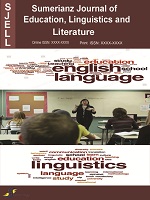Sumerianz Journal of Education, Linguistics and Literature

Online ISSN: 2617-1201
Print ISSN: 2617-1732
Quarterly Published (4 Issues Per Year)
Journal Website: https://www.sumerianz.com/?ic=journal-home&journal=33Archive
Volume 4 Issue 3 (2021)
Register as a Language Variation: A Linguistics Study of Advertising, Scientific and Official Writing
Authors : Egwim Favour Ogemdi ; Nwulu Nina Felicia ; Iroagba Chioma Gloria
DOI : doi.org/10.47752/sjell.43.84.91
Abstract:This paper considered register as a language variation in English Language. The register of civil service also known as official writing, advertisement and scientific writing are discussed in great details. The study was based on the premise that language is used in different ways to achieve set goals. The achievement of this set goal of a society results to growth and development of that given society. The paper considered language register as an important element of linguistic style used by different writers in different fields to effectively pass their message across to their readers. This paper equally discusses the scientific writing and advertisement register as the different registers used while elaborately paying attention to their differences in diction, sentence variety, clarity and conciseness. The style of writing in the civil service register is seen as being peculiar to the officialese and therefore is restricted to the officialdom. Poetic devices as a linguistic style were also identified as language register of advertisement. A good understanding of the Standard English will enhance a better appropriation of register in different fields of learning. The researcher used a descriptive research approach to collect data. Data collected were interpreted based on the context of the different sentences. The researcher recommends amongst other things that the officialese, scientific and advertisement writers go through proper training and retraining on the use of English language at its standard status.
Analytical Study in Algeria: The Question of the Division of Labor between Architects and Engineers Based On the Concept of the Oath and Complementarity
Authors : Mouloud Chaabi
DOI : doi.org/10.47752/sjell.43.73.83
Abstract:Nowadays, in Algeria, the institutional and practical context differs between the profession of architects and engineers. The latter are devoid of the concept of an oath. This concept can be the catalyst and generator of responsibility, equality, and merit between these two professions. To achieve complementarity between these two professions, an approach based on a questionnaire and interview on this situation is carried out at architectural design offices and minimal technical design offices in Algeria in order to bridge the gap created by the division of labor. Nationally, the work situation is sequential and linear. I.e. the engineer works under the responsibility of the architect. At the international level, the process is organized between architectural design offices and technical design offices, an iterative process. How to achieve this culture of complementarity of international practices. To validate this oath-based complementarity, this article reports on the results obtained and the prospects envisaged following this study.
Effectiveness of the HEART Program in Reframing the Needs and Aspirations of Commercial Sex Workers
Authors : Lovelyn C. Llanillo
DOI : doi.org/10.47752/sjell.43.62.72
Abstract:Commercial Sex Workers (CSWs) are subject to multiple experiences of mental and reproductive health issues. The study assessed the impact of a program based on Acceptance and Commitment Therapy (ACT), named Honing Effective Acceptance of oneself to Rebuild Valued Transformation (HEART). It aims to help CSWs to address needs and fulfill their aspirations despite experiences of suffering and distress. The intervention lasted six (6) sessions, with the entirety of the pre- and post-intervention, HEART program, and interviews spanning 13 days. The study utilized a snowball sampling approach, whereby thirty-two 32 CSWs were initially recruited, with a final count of twelve (12) CSWs obtained through a preliminary examination. A mixed methods approach, particularly the sequential explanatory technique was used to analyze the data. Quantitative results show significant increases in overall needs (p = .002) and aspirations (p = .002) pre-intervention and immediate post-intervention. Furthermore, significant results were found for both needs and aspirations (p = .002) pre-intervention and follow-up after two weeks. For immediate post-intervention versus follow-up, only needs (p = .003) and not aspirations (p = .587) was significant. For the three comparisons, there were significant differences in all sub-domains of needs and aspirations except for immediate post-intervention versus follow-up after two weeks. CSWs who participated regarded the program positively, noting significant changes occurring after their participation.



